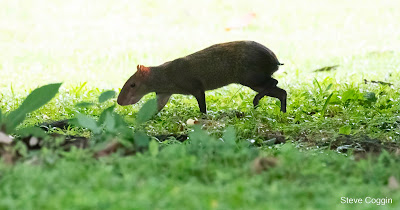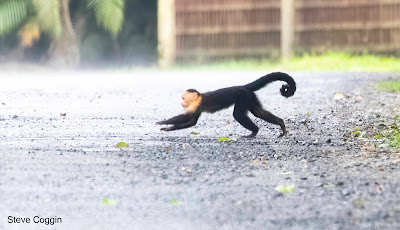 |
| A Brown-throated Three-toed Sloth (Bradypus variegatus) climbing a tree. Soberania National Park, Panama. |
Diane and I recently participated in a birding trip to Panama. The birds were there and they were amazing. We saw toucans, trogons, tanagers, tinamous and flycatchers, flycatchers and still more flycatchers. But surprisingly, we also saw lots of mammals. On other trips to the tropics we have seen a few mammals but in Panama they were abundant.
 |
| Canopy Tower, Panama. Photo courtesy of Diane Coggin. |
Our group stayed at the Canopy Tower in the lowland rainforest near the Panama Canal then moved to the Canopy Lodge in El Valle de Anton. This valley is really a caldera surrounded by the rim of an ancient volcano. This location is a little cooler and has rainforest, farms and on the peaks, cloud forest.
 |
| Brown-throated Three-toed Sloth. Soberania National Park, Panama. |
Sloths are iconic animals of the American tropics and we saw them every day. We saw both Hoffmann’s Two-toed Sloths (Choloepus hoffmanni) and Brown-throated Three-toed Sloths (Bradypus variegatus). Sloths live their lives slowly moving through the canopy of their tropical forest home. Their diet is mostly leaves but they will also eat flowers and fruits. Sloth metabolism is slow and they may take weeks to digest their high fiber meals. Hoffmann’s Two-towed Sloths are nocturnal and are the larger of the two species. Brown-throated Three-towed Sloths are smaller and are active in the day. Male Three-toed Sloths are easy to identify. They have a bright orange patch with a black line down the middle of their back. This unmistakable signal develops in males at sexual maturity and produces a musky smell that may attract female sloths.
 |
| A male Brown-throated Three-toed Sloth showing its orange and black patch on the back. Canopy Tower, Panama. |
One large and common mammal that we also saw every day was the Central American Agouti (Dasyprocta punctata). This large rodent is the size of an obese house cat. We would see agoutis in the daytime at forest edges and in fields searching for fruit. Because of their diet, agoutis are important seed dispersers for many tropical plants.
 |
| Central American Agouti (Dasyprocta punctata). Summit Botanical Gardens, Panama. |
 |
| Central American Agouti. Summit Botanical Gardens, Panama. |
One day, while we were hiking Pipeline Road, our guide Alex pointed out a furry head poking out of a tree hole over the trail. Our group was being watched by the beady eyes of a Rufous Soft-furred Spiny Rat (Diplomys labilis). This squirrel sized rat lives its entire life in trees, eating leaves and fruit.
 |
| Rufous Soft-furred Spiny Rat (Diplomys labilis) peeking from a tree hole. Pipeline Road, Panama. |
A common squirrel in the areas we visited was the Red-tailed Squirrel (Sciurus granatensis). Red-tailed Squirrels look very similar to the Eastern Gray Squirrel (Sciurus carolinensis) of North America. We saw a Red-tailed Squirrel collect a palm nut, run to another tree and proceed to devour it.
 |
| Red-tailed Squirrel (Sicurus granatensis) eating a palm nut. El Valle de Anton, Panama. |
While riding in a truck down a mountain road, we found four juvenile Nine-banded Armadillos (Dasypus novemcinctus) rooting on the shoulder. These young armadillos still had pink scales on their armored backs. The fact there were four young armadillos in this group was significant. During the development of Nine-banded Armadillos, the fertilized egg splits into four identical embryos so all armadillo births consist of identical quadruplets.
 |
| Nine-banded Armadillo (Dasypus novemcinctus) quadruplets foraging beside a forest road. Canopy Tower, Panama. |
There were many bats in Panama, most of which we could not identify. But at the Summit Botanical Garden, a group of Brown Tent-making Bats (Uroderma magnirostrum) was roosting on the underside of a palm frond. These bats have a dark brown bodies with white stripes on the head and back. At sunset the Brown Tent-making Bats fly forth to consume figs, flowers, nectar and sometimes insects.
 |
| Brown Tent-making Bats (Uroderma magnirostrum) roosting beneath a palm frond. Summit Botanical Gardens, Panama. Photo courtesy of Dr. Richard Pockat. |
Two racoon relatives came to the trees near the Canopy Tower at night. These were the Western Lowland Olingo (Bassaricyon medius) and the Kinkajou (Potos flavus). Both species are nocturnal and forage in the treetops looking for fruit, nectar and small animals. Kinkajous are the larger of the two and have long prehensile tails to aid in their high-speed travels through the canopy.
 |
| A Kinkajou (Potos flavus) at the Canopy Tower, Panama. |
 |
| Northern Tamandua (Tamandua mexicana). Canopy Tower, Panama. |
Panama has many species of primates (besides humans) and some of these fascinating creatures crossed our path. The most impressive were the Mantled Howler Monkeys (Alouatta palliata). These animals were large and black with a yellow mantle of hairs on their backs and sides. Mantled Howlers travel in large family groups, eating leaves and fruit. Howler Monkeys get their name from their booming vocalizations. Male Howlers produce roars that sound like the world’s largest jaguar and can be heard for miles in the thick forest.
 |
| Mantled Howler Monkey (Alouatta palliata) loafing in a rainforest tree. Canopy Tower, Panama. |
 |
| A female Mantled Howler Monkey moving through the canopy. Rainforest Discovery Center, Panama. |
 |
| A Panamanian White-faced Capuchin Monkey (Cebus imitator) scampering across a road. Gamboa Rainforest Resort, Panama. |
A group Geoffroy's Tamarins (Saguinus geoffroyi) would usually greet us in the morning at the Canopy Tower. These small monkeys have a striking black, white and brown color pattern and very long tails. The staff at the Canopy Tower use a clothesline to run bananas out to a nearby tree and the monkeys would come running.
 |
| A Geoffroy's Tamarin (Saguinus geoffroyi) contemplating the day. Canopy Tower, Panama. |
 |
| Geoffroy's Tamarin. Canopy Tower, Panama. |
The most interesting monkeys we saw came to the Canopy Tower at night They were Panamanian Night Monkeys (Aotus zonalis) and they fought over fruit provided by our hosts. Night Monkeys have large eyes as befits a nocturnal animal and they supplement their diet of fruit with leaves and insects.
 |
| Two Panamanian Night Monkeys (Aotus zonalis) eating a banana. Canopy Tower, Panama. |
When going to the tropics we expect to see large numbers of plant species, many types of insects and loads of birds. This visit to Panama delivered a surprising number of mammals. Humans have a close connection to mammals because we share so much with them. This is particularly true with monkeys, who are imperfect mirrors of ourselves.
 |
| This Brown-throated Three-toed Sloth just crossed a road and is headed for the trees. El Valle de Anton, Panama. |
No comments:
Post a Comment